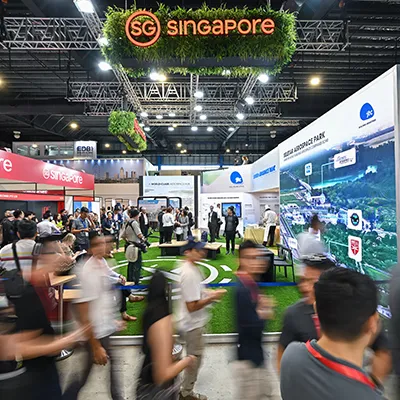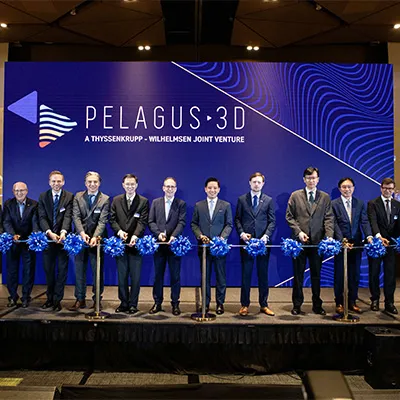Reshaping manufacturing through Industry 4.0 technologies
Manufacturing, long associated with being labour and capital intensive, is undergoing dramatic change. Coined the fourth industrial revolution, Industry 4.0 signifies the digitalisation of the entire manufacturing process and will form the basis of future manufacturing technologies.
“The latest revolution that we are witnessing is based purely on computing power,” said Nicholas Yeo, Technical Director at the Advanced Remanufacturing and Technology Centre (ARTC).
The future of manufacturing will allow for high-level integration between information, communication and manufacturing systems. By connecting multiple devices and machines at every step of the process, the model facilitates higher efficiency, flexibility and productivity across the whole value chain.
While manufacturing powerhouses such as Germany and the US are adopting Industry 4.0 in their own way, the wave of digitalisation has also hit the shores of Singapore and has been steadily gaining traction among its manufacturers.
Getting on board with AME
The manufacturing sector, considered the backbone of Singapore’s economy, accounts for nearly a fifth of its GDP and more than 400,000 jobs. However, recent constraints such as high costs, stagnant productivity and an ageing workforce amid a slowing global economy, have contributed to its sluggish growth.
The increasing demand for faster turnover and high-mix, low-volume products has made it challenging for this sector to continue with business-as-usual.
“Singapore manufacturers will need to upgrade their skills and technologies, and focus on high value production, if they are to maintain their competitive edge,” said Yeo.
In this regard, the government has prioritised funding for Advanced Manufacturing and Engineering (AME) – a key technology domain under Singapore’s Research, Innovation and Enterprise (RIE) plan for the next five years from 2016 to 2020. AME focuses on the development of technological capabilities in the areas of robotics and automation, digital manufacturing, additive manufacturing and advanced materials.
In order to graduate from a mere value addition model to a value creation model, it is imperative for the city state to embrace AME. This model could potentially address the island’s challenges and open up new opportunities for innovative business models and new revenue streams.
Public-private partnership is critical
However, implementing the model’s practices can be complex and daunting. A single organisation will find it difficult to develop and execute the entire spectrum of advanced manufacturing solutions.
“Public-private partnership will be required to develop a robust local ecosystem that can drive momentum and achieve future sustainability,” said Yeo.
ARTC is such a platform to develop advanced remanufacturing and manufacturing technologies under a public-private collaboration. Formally launched in 2015, ARTC is a partnership between A*STAR, NTU and industry partners. It is also Asia’s first centre for test-bedding and developing advanced manufacturing and remanufacturing technologies.
Remanufacturing entails converting end-of-life products into new products, through disassembly, cleaning and testing. Compared to traditional manufacturing processes, it uses less energy and generates less waste, and is often viewed as the future of manufacturing.
“Although the remanufacturing model has been in Singapore for a while, most of the technologies used, especially by the aerospace repair sector, are manual and labour intensive,” said Yeo.
To address this, ARTC has partnered with industry partners to conceptualise and offer advanced technologies, such as intelligent cyber-physical systems, advanced analytics and Industrial Internet of Things, to reduce costs and time to market.
Test bed for new technologies
Since AME involves both hardware and software changes, companies need to restructure their production processes and incorporate new concepts into their production line. This requires dedicated financial investment, time and effort.
“Many companies want to first evaluate the benefit of the advanced manufacturing technology before they adopt it,” said Yeo.
With this in mind, ARTC’s Model Factory depicts an end-to-end product manufacturing process. Here, companies can test the integration of smart, digital and advanced technologies with their current manufacturing processes to gauge the productivity and feasibility of the solutions.
“The Model Factory test bed helps eliminate the company’s risk in adopting a new technology,” said Yeo.
Multinational companies with large-scale regional operations can go beyond just testing ad hoc advanced manufacturing solutions and utilise the Model Factory to create a digital thread that cuts across all their manufacturing functions to optimise their operations.
Opportunity to showcase and co-develop solutions
It is essential for the manufacturing supply chain to make the transition too, if Singapore’s manufacturing sector wants to successfully adopt AME technologies.
ARTC provides a conducive environment for researchers and technology providers to engage with end users to discuss their real industry requirements and generate advanced manufacturing solutions accordingly.
“Once the solutions provider commercialises the technology, he can demonstrate its practical usage in the Model Factory,” said Yeo.
In 2016, local technology provider Sankei Eagle teamed up with ARTC to develop a machine to automate the masking process in the aerospace industry.
“The manual process was very painstaking as it involved sticking masking tape by hand on different aerospace components to cover the areas that needed to be protected from post processing,” said Yeo.
Instead, Sankei Eagle developed a machine that applied a liquid on the component through an automated process, which took half the time of taping the component by hand. The performance of the machine was demonstrated to end users such as Rolls-Royce, Singapore Aero Engine Services and International Engine Component Overhaul.
Building an AME-ready workforce
As advanced manufacturing grows in prominence, there will be a growing demand for highly-skilled labour to support its technologies. Therefore, Singapore needs to focus on increasing the depth of its manufacturing capacity through high-value manufacturing services.
“Currently, we see many companies who want to adopt a robotics solution but don’t have ample human capital for it,” said Yeo.
To plug this gap, ARTC’s Model Factory offers itself as a training ground for company employees to learn and apply robotics. Given that not many schools offer a comprehensive robotics programme, A*STAR is also looking to launch an academy model in the future, where students can take an elective with ARTC to help them gain practical experience in the manufacturing environment.
Keeping pace with an evolving landscape
With technologies evolving faster than ever, the manufacturing landscape is changing just as rapidly. Yeo pointed out that companies will have no choice but to be nimble, adaptable and scalable, to keep pace with these dynamic trends.
ARTC’s Model Factory became operational in the fourth quarter of 2017 and is expected to serve as an initial engine to drive the adoption of advanced manufacturing technologies in Singapore’s manufacturing sector.
“We also plan to roll out phase two and phase three models of the test bed to keep up with the ever-changing needs of the industry,” said Yeo.
ARTC’s focus on research and development, along with its strong consortium of industry members, is expected to provide solutions that will help drive the next industrial revolution in Singapore. This in turn will drive the transformation of the city-state into a lucrative destination for complex skill sets and high-value manufacturing components.






